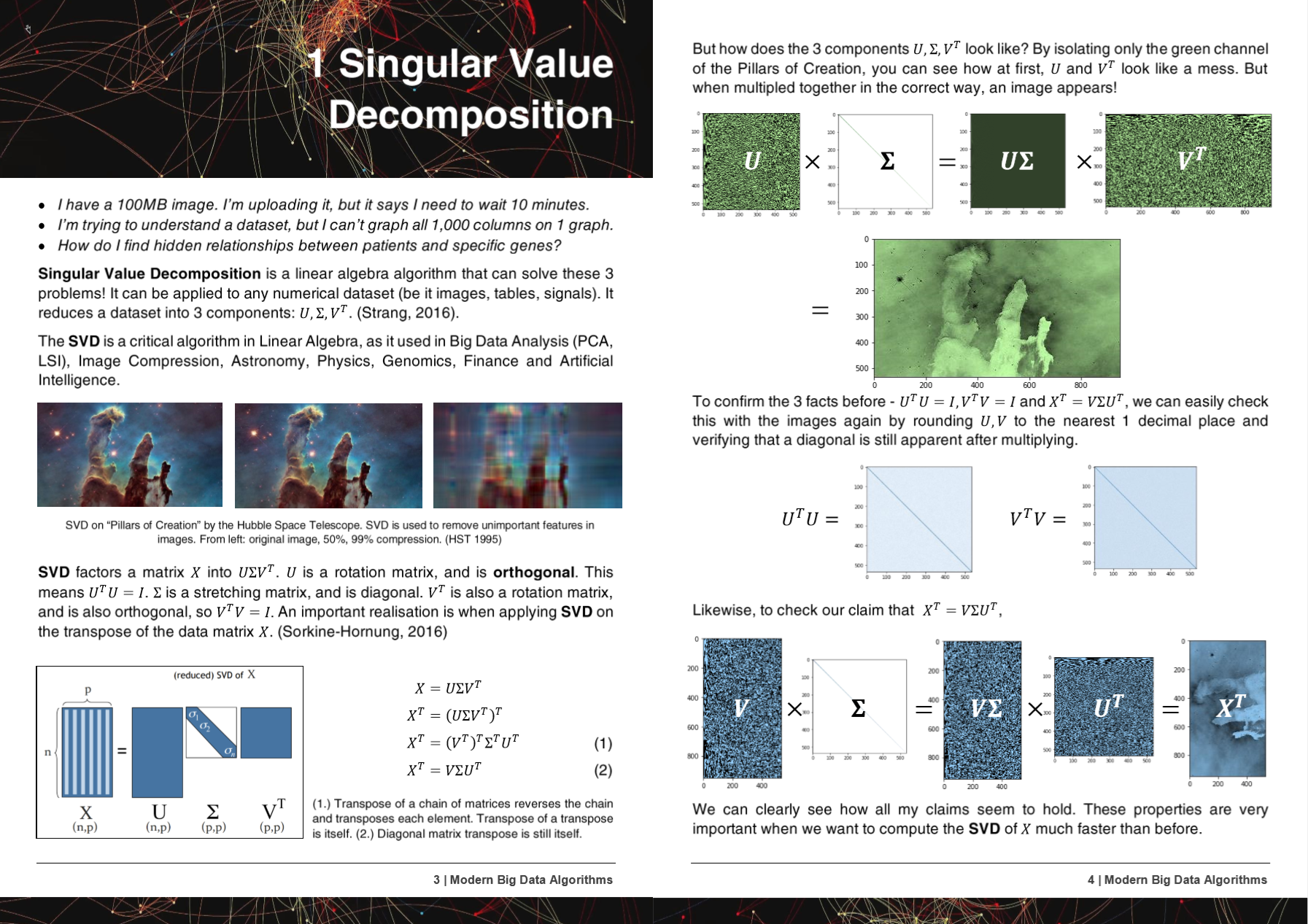If you want to collab on fast algorithms - msg me!! Join our Discord server on making AI faster, or if you just wanna chat about AI!! https://discord.gg/k8AtkZqNwr
! Hyperlearn is under construction! A brand new stable package will be uploaded sometime in 2022! Stay tuned!Moonshot Website
Documentation
50 Page Modern Big Data Algorithms PDF
In 2018-2020, I was at NVIDIA helping make GPU ML algos faster! I incorporated Hyperlearn's methods to make TSNE 2000x faster, and others faster. Since then, I have 50+ fast algos, but didn't have time to update Hyperlearn since Moonshot was priority one! I'll be updating Hyperlearn late 2022!
+ Microsoft, UW, UC Berkeley, Greece, NVIDIA- Microsoft: Yu et al. Making Classical Machine Learning Pipelines Differentiable https://learningsys.org/nips18/assets/papers/45CameraReadySubmissionfinetune.pdf
- University of Washington: Ariel Rokem, Kendrick Kay. Fractional ridge regression: a fast, interpretable reparameterization of ridge regression https://arxiv.org/abs/2005.03220
- National Center for Scientific Research 'Demokritos', Greece: Christos Platias, Georgios Petasis. A Comparison of Machine Learning Methods for Data Imputation https://dl.acm.org/doi/10.1145/3411408.3411465
- UC Berkeley David Chan. GPU Accelerated T-Distributed Stochastic Neighbor Embedding https://digitalassets.lib.berkeley.edu/techreports/ucb/incoming/EECS-2020-89.pdf (Incorporated Hyperlearn methods into NVIDIA RAPIDS TSNE)
- NVIDIA: Raschka et al. RAPIDS: Machine Learning in Python: Main developments and technology trends in data science, machine learning, and artificial intelligence https://arxiv.org/abs/2002.04803 (Incorporated Hyperlearn methods into NVIDIA RAPIDS TSNE)
Hyperlearn's methods and algorithms have been incorporated into more than 6 organizations and repositories!
+ NASA + Facebook's Pytorch, Scipy, Cupy, NVIDIA, UNSW- Facebook's Pytorch: SVD very very slow and GELS gives nans, -inf #11174 pytorch/pytorch#11174
- Scipy: EIGH very very slow --> suggesting an easy fix #9212 scipy/scipy#9212
- Cupy: Make SVD overwrite temporary array x cupy/cupy#2277
- NVIDIA: Accelerating TSNE with GPUs: From hours to seconds https://medium.com/rapids-ai/tsne-with-gpus-hours-to-seconds-9d9c17c941db
- UNSW Abdussalam et al. Large-scale Sku-level Product Detection In Social Media Images And Sales Performance https://www.abstractsonline.com/pp8/#!/9305/presentation/465
- GCC 10 ignoring function attribute optimize for all x86 since r11-1019 https://gcc.gnu.org/bugzilla/show_bug.cgi?id=96535
- Vector Extensions aligned(1) not generating unaligned loads/stores https://gcc.gnu.org/bugzilla/show_bug.cgi?id=98317
- GCC >= 6 cannot inline _mm_cmp_ps on SSE targets https://gcc.gnu.org/bugzilla/show_bug.cgi?id=98387
- GCC 10.2 AVX512 Mask regression from GCC 9 https://gcc.gnu.org/bugzilla/show_bug.cgi?id=98348
HyperLearn is written completely in PyTorch, NoGil Numba, Numpy, Pandas, Scipy & LAPACK, C++, C, Python, Cython and Assembly, and mirrors (mostly) Scikit Learn. HyperLearn also has statistical inference measures embedded, and can be called just like Scikit Learn's syntax.
Some key current achievements of HyperLearn:
- 70% less time to fit Least Squares / Linear Regression than sklearn + 50% less memory usage
- 50% less time to fit Non Negative Matrix Factorization than sklearn due to new parallelized algo
- 40% faster full Euclidean / Cosine distance algorithms
- 50% less time LSMR iterative least squares
- New Reconstruction SVD - use SVD to impute missing data! Has .fit AND .transform. Approx 30% better than mean imputation
- 50% faster Sparse Matrix operations - parallelized
- RandomizedSVD is now 20 - 30% faster
Around mid 2022, Hyperlearn will evolve to GreenAI and aims to incorporate:
- New Paratrooper optimizer - fastest SGD variant combining Lookahead, Learning Rate Range Finder, and more!
- 30% faster Matrix Multiplication on CPUs
- Software Support for brain floating point (bfloat16) on nearly all hardware
- Easy compilation on old and new CPU hardware (x86, ARM)
- 100x faster regular expressions
- 50% faster and 50% less memory usage for assembly kernel accelerated methods
- Fast and parallelized New York Times scraper
- Fast and parallelized NYSE Announcements scraper
- Fast and parallelized FRED scraper
- Fast and parallelized Yahoo Finance scraper
I also published a mini 50 page book titled "Modern Big Data Algorithm".
Modern Big Data Algorithms PDF
| Algorithm | n | p | Time(s) | RAM(mb) | Notes | ||
|---|---|---|---|---|---|---|---|
| Sklearn | Hyperlearn | Sklearn | Hyperlearn | ||||
| QDA (Quad Dis A) | 1000000 | 100 | 54.2 | 22.25 | 2,700 | 1,200 | Now parallelized |
| LinearRegression | 1000000 | 100 | 5.81 | 0.381 | 700 | 10 | Guaranteed stable & fast |
Time(s) is Fit + Predict. RAM(mb) = max( RAM(Fit), RAM(Predict) )
I've also added some preliminary results for N = 5000, P = 6000
- Including Memory Sharing, Memory Management
- CUDA Parallelism through PyTorch & Numba
- Matrix Multiplication Ordering: https://en.wikipedia.org/wiki/Matrix_chain_multiplication
- Element Wise Matrix Multiplication reducing complexity to O(n^2) from O(n^3): https://en.wikipedia.org/wiki/Hadamard_product_(matrices)
- Reducing Matrix Operations to Einstein Notation: https://en.wikipedia.org/wiki/Einstein_notation
- Evaluating one-time Matrix Operations in succession to reduce RAM overhead.
- If p>>n, maybe decomposing X.T is better than X.
- Applying QR Decomposition then SVD might be faster in some cases.
- Utilise the structure of the matrix to compute faster inverse (eg triangular matrices, Hermitian matrices).
- Computing SVD(X) then getting pinv(X) is sometimes faster than pure pinv(X)
- Confidence, Prediction Intervals, Hypothesis Tests & Goodness of Fit tests for linear models are optimized.
- Using Einstein Notation & Hadamard Products where possible.
- Computing only what is neccessary to compute (Diagonal of matrix and not entire matrix).
- Fixing the flaws of Statsmodels on notation, speed, memory issues and storage of variables.
- Using PyTorch to create Scikit-Learn like drop in replacements.
- Using Decorators & Functions where possible.
- Intuitive Middle Level Function names like (isTensor, isIterable).
- Handles Parallelism easily through hyperlearn.multiprocessing
- Matrix Completion algorithms - Non Negative Least Squares, NNMF
- Batch Similarity Latent Dirichelt Allocation (BS-LDA)
- Correlation Regression
- Feasible Generalized Least Squares FGLS
- Outlier Tolerant Regression
- Multidimensional Spline Regression
- Generalized MICE (any model drop in replacement)
- Using Uber's Pyro for Bayesian Deep Learning
Hyperlearn will be revamped in the following months to become Moonshot GreenAI with over an extra 150 optimized algorithms! Stay tuned!! Also you made it this far! If you want to join Moonshot, complete the secretive quiz!
Join Moonshot!
- The Apache 2.0 license is adopted.




